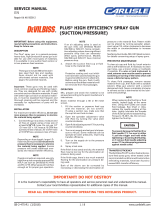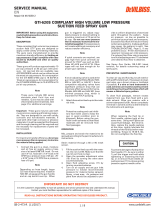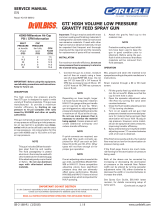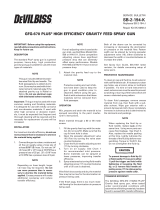
JGA CONVENTIONAL SPRAY GUN (SUCTION/PRESSURE)
IMPORTANT: Before using this equip-
ment, read all safety precautions and
instructions. Keep for future use.
DESCRIPTION
The standard JGA-504 spray gun is a general
purpose, heavy duty, high production spray
gun suitable for use with most types of ma-
terials. The fluid passageway is plated brass
and aluminum. The fluid tip and needle are
300 series stainless steel.
Halogenated hydrocarbon solvents
- for example; 1, 1, 1 - trichloroeth-
ane and methylene chloride - can
chemically react with the aluminum
in this gun and cause an explo-
sion hazard. Read the label or data
sheet for the material you intend to
spray. Do not use spray materials
containing these solvents with this
spray gun.
Important: This gun may be used with
most common coating and finishing
materials. It is designed for use with
mildly corrosive and nonabrasive materials.
If used with other high corrosive or
abrasive materials, it must be expected
that frequent and thorough cleaning will be
required and the necessity for replacement
of parts will be increased.
INSTALLATION
1. Attach the air supply line to the air inlet
(26). An air transformer installed as
close as possible to the gun will provide
filtered and regulated air.
Note
When larger diameter air hoses are
used, it is advisable to use an 8' or
10' "whip end" or a smaller diameter
hose at the gun for greater flexibility
or movement.
2. Attach the suction feed cup or fluid hose
to the material inlet.
Note
Protective coating and rust inhibi-
tors have been used to keep the gun
in good condition prior to shipment. Be-
fore using the gun, flush it with solvents
so that these materials will be removed
from fluid passages.
OPERATION
Mix, prepare and strain the material to be
sprayed according to the paint manufac-
turer's instructions.
Strain material through a 60 or 90 mesh
screen.
1. Fill the suction or pressure feed cup
with the material. Do not overfill. Make
sure that the cup lid vent hole is clear,
if using a suction cup.
2. Turn on the gun air at the source of sup-
ply. Adjust the atomization air pressure
to 35 psi.
3. Turn on the supply air to the pressure
cup if used.
4. Open the spreader adjustment valve
(10) (Fan) by turning the valve stem
counter-clockwise.
5. Open the fluid needle adjusting screw
(17) by turning counter-clockwise.
6. Spray a test area.
If the finish is too sandy and dry, the material
flow may be too low for the atomization air
pressure being used.
If the finish sags, there is too much mate-
rial flowing for the atomization air pressure
being used.
Both of the above can be corrected by
increasing or decreasing the atomization
air pressure or the material flow. Pattern
width can be altered by turning the spreader
adjustment valve (10), either clockwise to
decrease the width or counter-clockwise to
increase the width.
See Spray Gun Guide SB-2-001 (latest revi-
sion) for details concerning set up of spray
guns.
PREVENTIVE MAINTENANCE
To clean air cap and fluid tip, brush exte-
rior with a stiff bristle brush. If necessary
to clean cap holes, use a broom straw
or toothpick. Never use a wire or hard instru-
ment. This may scratch or burr holes causing
a distorted spray pattern.
To clean fluid passages, remove excess
material at source, then flush with a suit-
able solvent using a device such as the
SolventSaver™ (see Accessories). Wipe
gun exterior with a solvent dampened
cloth. Never completely immerse in
solvent as this is detrimental to the
lubricants and packings.
Note
When replacing the fluid tip or
fluid needle, replace both at the
same time. Using worn parts can
cause fluid leakage. See Charts 1 and
2. Also, replace the needle packing
at this time. Lightly lubricate the
threads of the fluid tip before
reassembling. Torque to 15-20 ft. lbs.
Do not overtighten the fluid tip.
To prevent damage to the fluid tip
(5) or fluid needle (11), be sure to
either 1) pull the trigger and hold
while tightening or loosening the
fluid tip or 2) remove fluid needle
adjusting screw (17) to relieve
spring pressure against needle
collar.
SB-2-259-E (6/2017) 1 / 8 www.carlisleft.com
EN
SERVICE MANUAL
IMPORTANT! DO NOT DESTROY
It is the Customer's responsibility to have all operators and service personnel read and understand this manual.
Contact your local DeVilbiss representative for additional copies of this manual.
READ ALL INSTRUCTIONS BEFORE OPERATING THIS DEVILBISS PRODUCT.
Repair Kit KK-5058-2

HAZARD CAUSE SAFEGUARDS
Fire
Solvent and coatings can be highly flammable Adequate exhaust must be provided to keep air free of
or combustible especially when sprayed. accumulations of flammable vapors.
Smoking must never be allowed in the spray area.
Fire extinguishing equipment must be present in the spray area.
Solvent
During use and while cleaning and flushing, Wear eye protection.
Spray
solvents can be forcefully expelled from fluid
and air passages. Some solvents can cause
eye injury.
Inhaling Toxic
Certain materials may be harmful if inhaled, or Follow the requirements of the Safety Data Sheet
Substances
if there is contact with the skin. supplied by your coating material manufacturer.
Adequate exhaust must be provided to keep the air free of
accumulations of toxic materials.
Use a mask or respirator whenever there is a chanced of inhaling
sprayed materials. The mask must be compatible with the
material being sprayed and its concentration. Equipment must be
as prescribed by an industrial hygienist or safety expert, and be
NIOSH approved.
Explosion Hazard -
Halogenated hydrocarbon solvents - for Guns with stainless steel internal passageways may be used
Incompatible
example; methylene chloride and 1, 1, 1 - with these solvents. However, aluminum is widely used in other
Materials
Trichloroethane are not chemically compatible spray application equipment - such as material pumps, regula-
with the aluminum that might be used in many tors, valves, this gun and cups. Check all equipment items before
system components. The chemical reaction use and make sure they can also be used safely with these
caused by these solvents reacting with solvents. Read the label or data sheet for the material you intend
aluminum can become violent and lead to to spray. If in doubt as to whether or not a coating or cleaning
an equipment explosion. material is compatible, contact your material supplier.
General Safety
Improper operation or maintenance of Operators should be given adequate training in the safe use and
equipment. maintenance of the equipment (in accordance with the require-
ments of NFPA-33, Chapter 15). Users must comply with all local
and national codes of practice and insurance company require-
ments governing ventilation, fire precautions, operation, main-
tenance and housekeeping. These are OSHA Sections 1910.94
and 1910.107 and NFPA-33.
Cumulative Trauma
Use of hand tools may cause cumulative Pain, tingling, or numbness in the shoulder, forearm, wrist,
Disorders (“CTD’s”)
trauma disorders (“CTD’s”). hands or fingers, especially during the night, may be early
symptoms of a CTD. Do not ignore them. Should you experience
CTD’s, or musculo- CTD's when using hand tools, tend to affect any such symptoms, see a physician immediately. Other early
skeletal disorders, the upper extremities. Factors which may symptoms may include vague discomfort in the hand, loss of
involve damage to increase therisk of developing a CTD include: manual dexterity, and nonspecific pain in the arm. Ignoring early
the hands, wrist, symptoms and continued repetitive use of the arm, wrist and
elbows, shoulders, 1. High frequency of the activity. hand can lead to serious disability. Risk is reduced by avoiding
neck and back. Carpal 2. Excessive force, such as gripping, pinching, or lessening factors 1-7.
tunnel syndrome and or pressing with the hands and fingers.
tendinitis (such as 3. Extreme or awkward finger, wrist, or arm
tennis elbow or positions.
rotator cuff 4. Excessive duration of the activity.
syndrome) are 5. Tool vibration.
examples of CTD’s. 6. Repeated pressure on a body part.
7. Working in cold temperatures.
CTD’s can also be caused by such activities
as sewing, golf, tennis bowling, to name a few.
The following hazards may occur during the normal use of this equipment.
Please read the following chart before using this equipment.
SAFETY PRECAUTIONS
This manual contains information that is improtant for you to know and understand. This information relates to USER SAFETY
and PREVENTING EQUIPMENT PROBLEMS. To help you recognize this information, we use the following symbols.
Please pay particular attention to these sections.
Note
Information that you should pay special
attention to.
Important safety information - A hazard
that may cause serious injury or loss
of life.
Important information that tells how
to prevent damage to equipment, or
how to avoid a situation that may
cause minor inury.
PROP 65 WARNING
WARNING: This product contains
chemicals known to the State of
California to cause cancer and birth
defects or other reproductive harm.
CA PROP
65
EN
SB-2-259-E (6/2017)2 / 8www.carlisleft.com

SPRAY GUN LUBRICATION
Daily, apply a drop of spray gun lube at
trigger bearing stud (28) and the stem
of air valve (20) where it enters air valve
assembly. The shank of fluid needle (11)
where it enters packing nut (9) should also
be oiled. Fluid needle packing (8) should
be lubricated periodically. Make sure
baffle (6) and retaining ring (3) threads
are clean and free of foreign matter.
Before assembling retaining ring to baffle,
clean the threads thoroughly, then add two
drops of spray gun lube to threads. Fluid
needle spring (14) and air valve spring (19)
should be coated with a very light grease,
making sure that any excess grease will
not clog the air passages. For best results,
lubricate the points indicated, daily.
A. Trigger Points
B. Packing
C. Adjusting Knobs
D. Baffle Threads
E. Air Valve Cartridge
PARTS REPLACEMENT
FLUID INLET GASKET (32)
REPLACEMENT INSTUCTIONS
1. Remove fluid inlet adapter (34) with
appropriate wrench.
2. Clean thread sealant from gun body
inlet threads and seal area.
3. Place gasket (32) squarely onto the
fluid inlet adapter and push it down
until it is flat against the shoulder.
4. Use medium strength thread sealant
(i.e. Devcon 2242 blue, or equal) on
threads before installing fluid inlet
adapter.
5. Torque fluid inlet adapter to 20-25 ft.
lbs. and tighten locknut.
PARTS REPLACEMENT
Figure 1 Air Cap
4. Assemble seal to baffle with angled
side up as shown in diagram. NOTE:
The seal should be a tight fit on the
baffle. If it is a loose fit on the baffle,
assure that it is assembled with the
angled side up.
5. Install baffle on gun.
6. Install fluid tip (5) and tighten to
15-20 ft-lbs.
JGA-4035 Packing Replacement Instruc-
tions
1. Remove adjusting knob and needle
spring from gun.
2. Partially withdraw needle from gun
body.
3. Loosen packing nut and remove.
4. Remove old packing.
5. Assemble packing nut to needle.
6. Assemble packing in order shown
to needle.
7. Insert needle all the way into gun
body seating in tip.
8. Install needle spring and adjusting
knob.
9. Thread packing nut into gun body.
10. Tighten packing nut in equal incre-
ments - no more than
1/6 turn at a time.
11. After each adjustment, pull needle
open and observe needle closure.
12. If needle snaps shut, continue
adjusting nut until there is evidence
of needle bind or slow closing.
13. Back off packing nut 1/12 turn to
the point where needle snaps shut.
Packing nut must remain tight
enough to prevent loosening by
hand.
14. Pull needle several times to verify
needle snaps shut and check pack-
ing nut for looseness.
Packing
(3 pieces)
Packing
Nut
Needle
Gun Body
GTI-33 Baffle Seal Replacement
1. Remove Fluid Tip (5).
2. Remove Baffle (6).
3. Remove Seal (7) from baffle.
NOTE
The seal is designed to be a tight
fit on the baffle. The seal should
be able to be removed using
your fingers. If you are unable
to remove the seal using your
fingers, insert a small screw-
driver between the outer lip and
the back of the baffle and pry
the seal off.
A
C
D
B
E
Chart 1
No. on
Air Cap
Order
No.
Air Caps, Fluid Tips, Fluid Needles and Applications
Air Cap
With Ring
(Ref. No. 4)
Type of
Fluid
Delivery
Fluid
Needle
(Ref. No. 11)
Fluid Tips
Used
(Ref. No. 5)
Fluid
Needle
(Ref. No. 11)
Fluid Tips
Used
(Ref. No. 5)
Suction Feed Pressure Feed
80
MB-4039-80
SUCTION GTI-413
AV-213-16
OR
AV-213-18
9000
AV-440-9000
SUCTION
OR
PRESSURE
GTI-413 GTI-449-12
AV-213-16
OR
AV-213-18
765
AV-440-765
PRESSURE GTI-449-12 AV-213-12
777
AV-440-777
PRESSURE GTI-449-12 AV-213-14
AV-213-10
OR
AV-213-12
ANGLED SIDE
THICK SIDE
SEAL
BAFFLE
Pry here if
necessary
DeVilbiss
N
o
XX
Air Cap No.
Fluid Tips Available
Tip Size
Fluid Tip
(Ref. No. 5)
Type of Fluid
Delivery
in. mm
0.039 1.0 AV-213-10 Pressure Feed
0.047 1.2 AV-213-12 Pressure Feed
0.055 1.4 AV-213-14 Pressure Feed
0.063 1.6 AV-213-16 Suction Feed
0.070 1.8 AV-213-18 Suction Feed
Chart 2
EN
SB-2-259-E (6/2017) 3 / 8 www.carlisleft.com

PARTS LIST
Ind.
Ref. Replacement Parts
No. Part No. Description Req.
1 --- Air Cap 1
2 JGA-156-K10 Spring Clip (Kit of 10) 1
3 GTI-3 Air Cap Retaining Ring 1
4 See Chart 1 Air Cap & Retaining Ring 1
5 See Charts 1 & 2 Fluid Tip 1
6 GTI-425 Baffle Assembly 1
•7 GTI-33-K5 Baffle Seal (Kit of 5) 1
•8 JGA-4035-K5 Packing (Kit of 5) 1
9 34411-122-K10 Packing Nut 1
10 GTI-405 Spreader Valve Assembly 1
11 See Chart 1 Fluid Needle 1
•12 JGS-72-K10 Gasket Kit (PTFE) 2
(Kit of 10)
13 --- Body Bushing 1
•14 --- Fluid Needle Spring 1
•15 --- Spring Pad 1
16 MBD-19-K10 Spring and Pad 1
(Kit of 10)
17 GTI-414 Needle Adjusting Screw 1
18 KK-5059 Bushing, Spring, Pad and 1
Knob Kit
•19 --- Air Valve Spring 1
•20 --- Air Valve 1
21 --- Air Valve Body 1
Ind.
Ref. Replacement Parts
No. Part No. Description Req.
•22 --- U Cup Seal 1
•23 --- Washer 1
•24 --- Snap Ring 1
25 JGS-449-1 Air Valve Assembly 1
26 P-MB-51 Air Inlet Nipple 1
1/4" NPS(M)
27 --- Trigger Stud Screw 1
28 --- Trigger Stud 1
29 JGS-478 Stud and Screw Kit 1
30 --- Trigger 1
31 JGS-477-1 Trigger, Stud & Screw Kit 1
•32 --- Fluid Inlet Gasket (PTFE) 1
33 --- Locknut 1
34 --- Fluid Inlet Adapter 1
35 JGA-4042 Fluid Inlet, Gasket, Nut Kit 1
•36 --- Retaining Clip 1
•37 --- Seal 1
•38 --- Pin 1
39 GTI-428-K5 Clip, Seal & Pin Kit (5 each) 1
40 --- Plug 1
• KK-5058-2 Gun Repair Kit includes a quantity of necessary parts.
Suffixes -K5, -K10 designate kits of multiple parts.
Example: JGA-4035-K5 is a kit of 5 packings.
6
4
2
8
24
3
29
31
*26 Air Inlet Nipple
1/4" NPS(M)
(torque to 15 ft. lbs.)
16
17
14
9
11
10
*34
32
Fluid Tip
(Torque to
15-20 ft. lbs.)
33
1
15
12
13
18
23
22
21
20
19
12
25
28
27
30
*Use medium strength
thread sealant (i.e.
Devcon #2242 Blue,
or equal) on threads.
35
Fluid Inlet Nipple
3/8" NPS(M)
(torque to 20-25 ft. lbs.)
7
5
36 37 38
39
OR
40
4
EN
SB-2-259-E (6/2017)4 / 8www.carlisleft.com

TROUBLESHOOTING
CONDITION CAUSE CORRECTION
Heavy top or
Horn holes plugged. Clean. Ream with nonmetallic point.
bottom pattern
Obstruction on top or bottom of fluid tip. Clean.
Cap and/or tip seat dirty. Clean.
Heavy right or
Left or right side horn holes plugged. Clean. Ream with nonmetallic point.
left side pattern
Dirt on left or right side of fluid tip. Clean.
Remedies for the top-heavy, bottom-heavy, right-heavy and left-heavy patterns:
1) Determine if the obstruction is on the air cap or the fluid tip. Do this by making a test spray
pattern. Then, rotate the cap one-half turn and spray another pattern. If the defect is inverted,
obstruction is on the air cap. Clean the air cap as previously instructed.
2) If the defect is not inverted, it is on the fluid tip. Check for a fine burr on the edge of the fluid tip.
Remove with #600 wet or dry sand paper.
3) Check for dried paint just inside the opening. Remove paint by washing with solvent.
Heavy center pattern
Fluid pressure too high for atomization Balance air and fluid pressure.
air (pressure feed). Increase spray pattern width with spreader
adjustment valve.
Material flow exceeds air cap's capacity. Thin or lower fluid flow.
Spreader adjustment valve set too low. Adjust.
Atomizing pressure too low. Increase pressure.
Material too thick. Thin to proper consistency.
Split spray pattern
Atomization air pressure too high. Reduce at transformer or gun.
Fluid pressure too low (pressure feed only). Increase fluid pressure (increases gun
handling speed).
Spreader adjusting valve set too high. Adjust.
Jerky or fluttering spray
*Loose or damaged fluid tip/seat. Tighten or replace.
Material level too low. Refill.
Container tipped too far. Hold more upright.
Obstruction in fluid passage. Backflush with solvent.
Loose or broken fluid tube or fluid inlet nipple. Tighten or replace.
Dry or loose fluid needle packing nut. Lubricate or tighten.
Unable to get round spray
Spreader adjustment screw not seating properly. Clean or replace.
Air cap retaining ring loose. Tighten.
Will not spray
No air pressure at gun. Check air supply and air lines.
Internal mix or pressure feed air cap and tip Change to proper suction feed air cap and tip.
used with suction feed.
Fluid pressure too low with internal mix cap and Increase fluid pressure at tank.
pressure tank.
Fluid needle adjusting screw not open enough. Open fluid needle adjusting screw.
Fluid too heavy for suction feed. Thin material or change to pressure feed.
Starved spray pattern
Inadequate material flow. Back fluid adjusting screw out to first thread
or increase fluid pressure at tank.
Low atomization air pressure (suction feed) Increase air pressure and rebalance gun.
Excessive overspray
Too much atomization air pressure. Reduce pressure.
Gun too far from work surface. Adjust to proper distance.
Improper stroking (arcing, gun motion too fast).
Move at moderate pace, parallel to work surface.
Excessive fog
Too much, or too fast-drying thinner. Remix properly.
Too much atomization air pressure. Reduce pressure.
Dry Spray
Air pressure too high. Reduce air pressure.
Gun tip too far from work surface. Adjust to proper distance.
Gun motion too fast. Slow down.
Gun out of adjustment. Adjust.
Fluid leaking from
Packing nut loose. Tighten, do not bind needle.
packing nut
Packing worn or dry. Replace or lubricate.
Paint bubbles in cup.
Fluid tip not tight. Tighten tip to 15-20 ft. lbs.
*Most common problem.
EN
SB-2-259-E (6/2017) 5 / 8 www.carlisleft.com

CONDITION CAUSE CORRECTION
Fluid leaking or dripping
Packing nut too tight. Adjust.
from front of gun
Dry packing. Lubricate.
Fluid tip or needle worn or damaged. Replace tip and needle.
Foreign matter in tip. Clean.
Fluid needle spring broken. Replace.
Wrong size needle or tip. Replace.
Runs and sags
Too much material flow. Adjust gun or reduce fluid pressure.
Material too thin. Mix properly or apply light coats.
Gun tilted on an angle, or gun motion Hold gun at right angle to work and adapt to
too slow. proper gun technique.
Thin, sandy coarse finish
Gun too far from surface. Check distance. Normally approx. 6-8".
drying before it flows out
Too much air pressure. Reduce air pressure and check spray pattern.
Improper thinner being used. Follow paint manufacturer'smixing instructions.
Thick, dimpled finish
Gun too close to surface. Check distance. Normally approx. 6-8".
"orange peel".
Too much material coarsely atomized. Air pressure too low.
Increase air pressure or reduce fluid pressure.
Improper thinner being used. Follow paint manufacturer'smixing instructions.
Material not properly mixed. Follow paint manufacturer'smixing instructions.
Surface rough, oily, dirty. Properly clean and prepare.
Troubleshooting (continued)
EN
SB-2-259-E (6/2017)6 / 8www.carlisleft.com

WR-103
Wrench
Contains all neces-
sary tip, hose and
nut sizes used on
or with gun.
ACCESSORIES
Automotive Quick Connects For HVLP
Guns (Air) High Flow Type.
HC-4720
Coupler
1/4" NPT(F)
HC-1166 Stem
1/4" NPT(M)
HC-4419 Stem
1/4" NPT(F)
HC-4719
Coupler
1/4" NPT(M) /
NPS(M)
HARG-510
Air Regulator
Use to maintain
nearly constant
outlet pressure de-
spite changes in
inlet pressure and
downstream flow.
HAV-500 OR
HAV-501
Adjusting
Valve
(HAV-501 SHOWN)
HAV-500 does not
have pressure
gauge. Use to con-
trol air usage at gun.
40-128 Twin
Cartridge,
Paint Spray
Respirator
NIOSH-Certified
(TC-84A-1623 for
respiratory protec-
tion in atmospheres
not immediately
dangerous to life.
Spray Gun Lube
SSL-10
(2 oz. bottle)
Compatible with
all paint materi-
als; contains no
silicone or petro-
leum distillates to
contaminate paint.
SDS Sheet avail-
able upon request.
192212 Professional Spray Gun Cleaning Kit
Contains six precision tools designed to effectively
clean all DeVilbiss, Binks, Finishline and other brand
spray guns.
192218 Scrubs
®
Hand Cleaner
Towels
Premoistened
waterless hand
cleaner towels for
painters, body men
and mechanics.
JGA-156-K10
Spring Clip
Joins any single
piece DeVilbiss air
cap with latest ver-
sion retaining ring.
Helps prevent part
loss and provides
easier assembly.
TGC-545 (Alum.)
2 Qt. Drip Free
Suction Cup
Cup has a unique,
two position valve
which permits se-
lection of either a
drip-free or con-
ventional open vent
mode.
GTI-415
Air Adjusting
Valve
Installs into gun to
enable user to con-
trol and reduce air
usage at the gun.
Replaces JGA-132
plug.
HAF-507
Whirlwind™
In-Line Air Filter
Removes water, oil,
and debris from the
air line.
EN
SB-2-259-E (6/2017) 7 / 8 www.carlisleft.com

EN
SB-2-259-E (6/2017)8 / 8www.carlisleft.com
WARRANTY POLICY
DeVilbiss products are covered by Carlisle Fluid Technologies one year materials and workmanship
limited warranty. The use of any parts or accessories, from a source other than
Carlisle Fluid Technologies, will void all warranties. For specic warranty information please contact
the closest Carlisle Fluid Technologies location listed below.
Carlisle Fluid Technologies reserves the right to modify equipment specications without prior notice.
DeVilbiss
®
, Ransburg
®
, ms
®
, BGK
®
, Binks
®
, TEKNA
®
, FinishLine
®
, StartingLine
®
, CamAir
®
, CVi
®
, PLUS
®
, GTi
®
,
and PRi
®
are registered trademarks of Carlisle Fluid Technologies, Inc.
©2017 Carlisle Fluid Technologies, Inc.
All rights reserved.
USA/Canada
www.autorenishdevilbiss.com
Toll Free Tel: 1-800-445-3988
Toll Free Fax: 1-800-445-6643
Mexico
www.autorenishdevilbiss.com.mx
Toll Free Tel: 1-888-835-6232 USA
DeVilbiss Automotive Renishing is part of Carlisle Fluid Technologies,
a global leader in innovative nishing technologies. For technical assistance
or to locate an authorized distributor, contact one of our international sales
and customer support locations.
/










